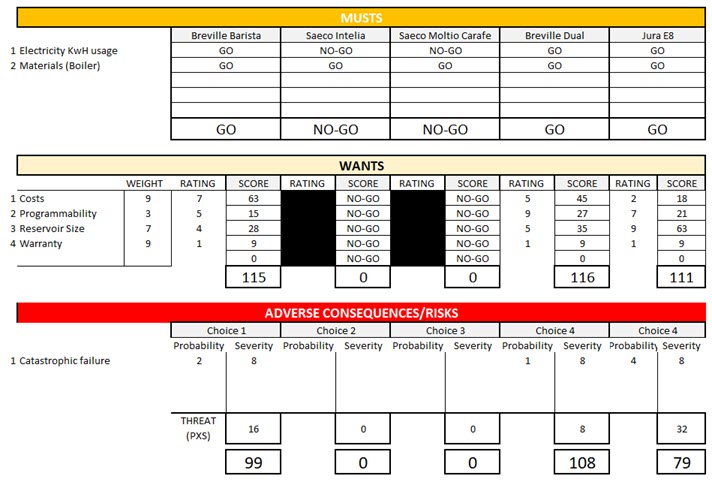KT the DA Away
For the purpose of this session, we will focus not on the Kepner Tregoe (KT) method in general (as interesting as it is) but on the KT Decision Tool! What separates this approach from other DA tools? As expressed on the Mindtools article exploring the KT tool, the notion of finding the "bullet proof" or perfect decision is rejected. The approach centers on finding the "best possible decision" without mistaking the decision as risk proof.
Here is the process:
Example
Here is a static snapshot showing one possible configuration of the KT tool:
In this case, a group of "volunteers" were asked to imagine themselves as the owners of an imaginary cafe and were tasked with selecting one coffee machine among five possible choices. Within the top portion of the tool, the volunteers were asked to identify strategic attributes, i.e. those "must have" qualities for a coffee maker. If the model could not satisfy these strategic needs, then a status of "no-go" was assigned.
In the next portion of the tool, the volunteers were asked to identify tactical attributes, i.e. those "nice to have" qualities for a coffee maker. A weight was established and a ranking created for each machine per attribute. At the bottom of this portion an aggregate was compiled and allowed for quantitative comparison. In this case, the fourth machine (the Breville Dual) at this point in the process seemed to be the best choice.
As the KT method is a "real-world" approach that strives to find the "best possible approach," prior to making a final assessment risks were admitted and added into the final metric. In this case, warranty data was used to assign a risk number reflecting catastrophic (total) failure. In the end, the fourth machine (the Breville Dual) possessed the most favorable assessment.
Bottom Line:
The KT tool is a very accessible yet data-driven approach that should minimize advocacy, bias, and subjectivity.
For the purpose of this session, we will focus not on the Kepner Tregoe (KT) method in general (as interesting as it is) but on the KT Decision Tool! What separates this approach from other DA tools? As expressed on the Mindtools article exploring the KT tool, the notion of finding the "bullet proof" or perfect decision is rejected. The approach centers on finding the "best possible decision" without mistaking the decision as risk proof.
Here is the process:
- State a decision
- Describe ad classify objectives - list the must haves and the nice to haves
- List the limits - all decisions and scenarios have them
- Rank & assign weights to your must and nice to haves
- Generate and evaluate alternatives
- Evaluate risks
- Make a decision
Example
Here is a static snapshot showing one possible configuration of the KT tool:

In this case, a group of "volunteers" were asked to imagine themselves as the owners of an imaginary cafe and were tasked with selecting one coffee machine among five possible choices. Within the top portion of the tool, the volunteers were asked to identify strategic attributes, i.e. those "must have" qualities for a coffee maker. If the model could not satisfy these strategic needs, then a status of "no-go" was assigned.
In the next portion of the tool, the volunteers were asked to identify tactical attributes, i.e. those "nice to have" qualities for a coffee maker. A weight was established and a ranking created for each machine per attribute. At the bottom of this portion an aggregate was compiled and allowed for quantitative comparison. In this case, the fourth machine (the Breville Dual) at this point in the process seemed to be the best choice.
As the KT method is a "real-world" approach that strives to find the "best possible approach," prior to making a final assessment risks were admitted and added into the final metric. In this case, warranty data was used to assign a risk number reflecting catastrophic (total) failure. In the end, the fourth machine (the Breville Dual) possessed the most favorable assessment.
Bottom Line:
The KT tool is a very accessible yet data-driven approach that should minimize advocacy, bias, and subjectivity.






